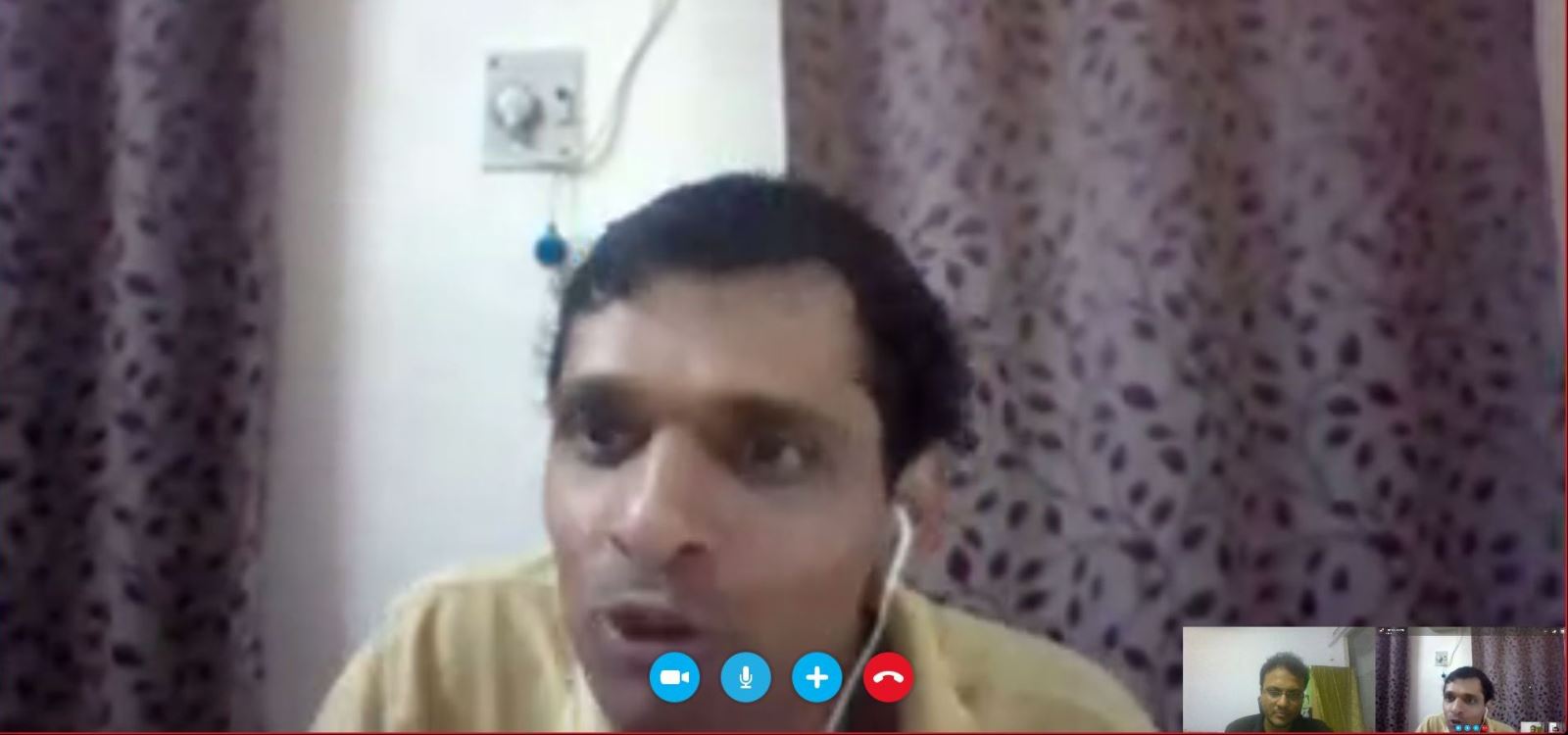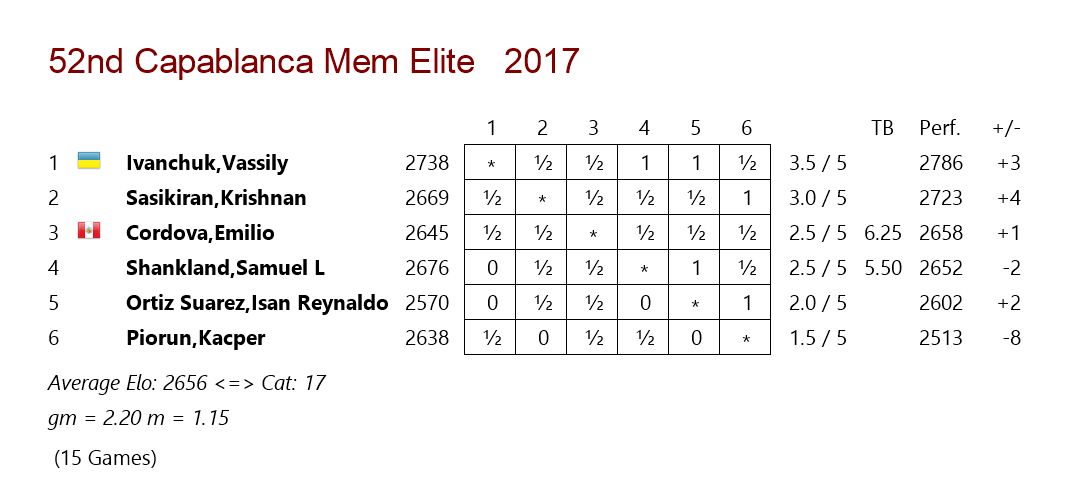


In case you have missed it, read the first part here:
Sasikiran wins 52nd Capablanca Memorial 2017
In the first part we dealt with how Sasikiran approached the Capablanca Memorial tournament and how he prepared for it. Sasikiran spoke about how the Benasque Open 2016 helped him to completely have a new direction towards how he played chess. Along the way he won the Rilton Cup and this was followed by his excellent performance at the Capablanca Memorial 2017, where he won the tournament. We analyzed the first five games of the event with Sasi providing excellent insights about all the encounters. This included a win over Piorun Kacper in round one and four highly exciting and eventful draws.

The interview was conducted on Skype with Sasikiran at his home in Chennai

This is how things stood at the end of the first half of the tournament. Ivanchuk was leading, and Sasikiran was in second, half a point behind.
The day before the sixth round was a rest day. Sasikiran spent the day as if it was any other at the tournament. He followed the same schedule, practicing at the time the round would usually occur.
"I think it is very important to keep your head running", says Sasi. "Because if you relax, you have to remember that the next day you have to be at the board again playing a game of chess. I prefer to spend it normally, just like other days of the tournament, rather than going out for sight seeing", he added.

Focus, concentration and intensity | Photo: Amruta Mokal
This was a confidence boosting draw for Sasikiran. After landing into a difficult position from the opening, the Indian GM did well to wriggle out of the mess. But near the 40th move, he made a huge mistake that put him in a very difficult rook endgame. Piorun played really well and was on course to win the game. All he had to do was show some subtle play in the rook endgame. But he failed to do so and the game was drawn. "Things would have been completely different had I lost this game", said Sasi.
White is clearly better here. How should he continue in order to win the game? The answer is in the annotations below.
One of the important things I learned from the above position and Sasi's analysis is that keeping control is good, but when the time comes, you need to head for complications and calculate accurately. Only then can you convert such advantageous positions into a win.
Sasikiran began the game with 1.e4 and Ivanchuk played the Petroff. After the opening phase of the game, according to Sasikiran, he had a very pleasant advantage. He could improve and open the position whenever he liked with the move g4!, while Ivanchuk didn't really have any active plans. However, Sasi didn't play so well and soon it was the Ukrainian GM who had a better position. Both the players made errors close to the time control, and on move 38 they both agreed to a draw. The final position is interesting and the game could have gone either way, but objectively it should be a draw.

When we reached this position, Sasi quickly said White is better. I was unable to understand. If anyone looks better, it has to be Black I thought. But then Sasi explained to me that White has a clear plan of playing g4 in the position and opening up lines towards the black king. While Black doesn't really have an active plan. This was quite an important revelation for me.

Look at his concentration! Ivanchuk faces Cuban checkers National Champion Carlos Rivero. The match ended 2-1 in Carlos' favour | Photo by Lisychess
Video of Ivanchuk playing checkers against GM Juan Borges
This was the most beautiful game of the tournament for Sasi. I like to call it the "light square symphony". At first glance if you look at the game you might think that Sasi completely outplayed his opponent. But on closer inspection you will realize that Shankland could have repeated the position and agreed for a draw. He was in an ambitious mood and played moves that the position was not yet ready for.
Once he got the opportunity, Sasi played all the good moves, sacrificed an exchange and won a fine game.

Position after 28.Rb4
The move made by Sasi in this position was 28...Rc4. Why didn't he play ...Rc2? Many times in our annotations we leave it at that, but while talking to him, I realized that Sasi was afraid of the exchange sac with Rxe4 dxe4 Rf2. He was trying to find a way for Black to win as Bb4 is coming up. This is the reason why he gave up on the move, although later he realized that Bg4-e2 will simply win the game.
Sasikiran was able to execute a new opening idea that he had prepared. With a quick g4 and f5, the game was already over after the first eleven moves. "If I don't do anything stupid, I would win this", is how Sasikiran likes to put it.

Position after 7...b6
8.Ne2!? was Sasikiran's interesting opening idea. The plan is not only to play c3 and bolster the centre, but also to go for g4, f5 break when the knight would be well placed to jump to g3 or f4. This game is a clear case of how a well-prepared opening idea can give you a full point against a strong opponent without too much effort.
Sasikiran was in the lead by half a point going into this round. He agreed to a quick draw with Ortiz Suarez in just 15 moves. Did he not fear that Ivanchuk could beat Shankland and catch him?
"The last closed round-robin event I had won was way back in 2008. I didn't win anything after that. So I decided to take a draw and at least get a share of the first place," Sasi explained.
In the end Ivanchuk lost his game to Shankland and Sasikiran emerged as the champion by one point margin.
The final crosstable:
| Rk. | Name | Rtg. | Nt. | Pts. | n | 1 | 2 | 3 | 4 | 5 | 6 | TB | Perf. | ||
|---|---|---|---|---|---|---|---|---|---|---|---|---|---|---|---|
|
1 |
GM |
|
2669 |
 |
6.5 |
10 |
|
30.50 |
2763 | ||||||
|
2 |
GM |
|
2738 |
 |
5.5 |
10 |
|
26.00 |
2676 | ||||||
|
3 |
GM |
|
2676 |
 |
5.5 |
10 |
|
25.00 |
2688 | ||||||
|
4 |
GM |
|
2638 |
 |
5.0 |
10 |
|
24.25 |
2660 | ||||||
|
5 |
GM |
|
2570 |
 |
4.0 |
10 |
|
20.25 |
2601 | ||||||
|
6 |
GM |
|
2645 |
 |
3.5 |
10 |
|
18.00 |
2548 | ||||||
| TBs: Sonneborn-Berger | |||||||||||||||

Sasikiran with the winner's trophy, flanked by Ivanchuk on the right (second) and Shankland on the left (third)
I have called Sasikiran in many of my articles as the Rahul Dravid of Indian chess. Rahul Dravid is one of the most respected players in the world of cricket. He is also known as the "Wall", because of his extremely solid and dependable style of batting. Somehow I feel that Sasikiran is the Mr. Dependable of Indian chess. The way he has been playing chess consistently over the years. He is always ready to represent India and be a part of the team in important events like Olympiad, World and Asian Teams etc. He has won so many international tournaments ahead of strong grandmasters. Besides, he is extremely hard working and modest, just like Rahul Dravid!
I didn't know whether Sasi actually liked the fact that he was called the Rahul Dravid / Wall of Indian chess. This was the perfect moment to clarify that point.
"I know you call me that. I have read it. Yes, I like Rahul Dravid very much. In fact I am reading his autobiography right now. He is the only cricketer whose book I have read."

Mr. Dependable of Indian chess
After the game analysis ended I asked Sasi about his future aims.
"I am just enjoying chess! So I would like to continue working hard and continue playing. Apart from that I do not have any aims!" We wish him the best and hope that he crosses the 2700 Elo mark soon.